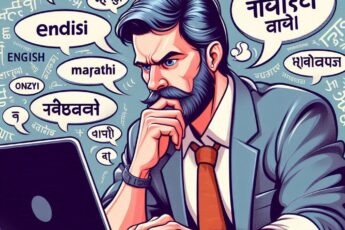
Is typing multilingual text part of your daily routine? If so, you might resonate with my experience. As someone immersed in multimedia services, my work necessitates constant toggling between different languages. Each day involves researching, thinking, writing, reading, and translating in Gujarati, Hindi, Marathi, and English for my clients. Initially, the advent of accessible Indic language typing felt like a boon, simplifying my tasks. However, over time, I’ve found this daily multilingual typing to be increasingly cumbersome, particularly when done in high volumes.
The Technical Challenge: Most people (98 out of 100, in fact) use phonetic keyboards. However, I prefer the DOE (Devanagari Online Editor) keyboard, which is favoured in the media industry. For those unfamiliar, let me illustrate the difference: to type “Meri” or “मेरी” in HIndi using a phonetic keyboard, you press M-E-R-I or M-E-R-E-E. On the DOE keyboard, the same word is typed using the keys c-s-j-r. The DOE keyboard requires fewer keystrokes, doesn’t necessitate constant grammatical corrections, and is generally more accurate.
The Psychological Strain of Constant Multilingual Thinking: Continuously thinking in multiple languages is mentally draining. A peaceful mind is hard to maintain under such compulsion.
The Strain of Frequent Keyboard Switching: Changing the keyboard output requires pressing specific keys (SHIFT and ALT on my keyboard). This constant toggling adds another layer of complexity and distraction.
Special Characters and Numbers: Typing special characters in Indic languages requires extra effort. Moreover, most Unicode Indic keyboards don’t support typing numbers in Indian languages. This limitation forces us to either use English numbers or expend additional effort to type them in the desired language.
Aesthetic and Grammatical Dilution: The surge in language typing has compromised many aesthetic and fundamental aspects of our languages. For instance, there’s a difference in typing Hindi, Gujarati, and Marathi. In Hindi, a suffix is typically typed separately from a word, whereas in Gujarati and Marathi, it is attached to the word. Major tech companies like Google haven’t always respected these nuances, leading to the propagation of incorrect grammar and writing styles among English educated users. This has inadvertently damaged our linguistic heritage. Being part of a generation that grew up without Google and keyboard toggling, I can type correctly. However, reviewing and correcting texts from others, including clients, demands significant effort.
The Shift from Paper to Digital: In the past, I wrote everything on paper before typing, allowing for focused work on a single language. This method provided opportunities for thorough review and peaceful refinement. Now, receiving and creating text digitally, working on multiple languages simultaneously has become unavoidable due to online multilingual research.
The Joy and Challenge of Typing: I enjoy the physical act of typing when working in one language. My hands and mind cooperate seamlessly. However, when working in multiple languages, it becomes chaotic. This may be due to overexertion, ageing, or other unknown factors. Despite the challenges, my passion for writing, translation, research, and reading keeps me going. This multifaceted work is both my profession and my passion.
The Benefits and Joys of Multilingual Typing: I must also highlight the numerous benefits and joys of multilingual typing. Firstly, it enhances cognitive flexibility as constantly switching between languages sharpens the mind and improves problem solving skills. Secondly, it opens up professional opportunities for me and my company to work with a diverse range of clients, allowing for greater creativity and cultural exchange. Thirdly, my work is deeply rewarding because it fosters a sense of accomplishment and connection to my linguistic heritage. Fourthly, language variation keeps my tasks interesting and engaging, preventing monotony. Finally, it lets me access a wealth of information and resources across different languages, enriching me personally and professionally.
Your Perspective?: Do you engage in extensive multilingual typing? If so, do you face similar challenges? Your insights and experiences would be valuable in understanding this complex, yet fascinating, aspect of modern multimedia work. I would be happy to read your view in the comments section. Thank you!
(Sanjay is a Mumbai-based writer, journalist, and
linguist.)




 Hello. I am Sanjay V. Shah. I live in Mumbai, India. I am a journalist and an author since 1995. I have been associated with leading Gujarati and English publications since the very beginning of my career.
Here, I will share my articles with you on varied subjects. Read, enjoy, and do leave your feedback. Thanks!
Hello. I am Sanjay V. Shah. I live in Mumbai, India. I am a journalist and an author since 1995. I have been associated with leading Gujarati and English publications since the very beginning of my career.
Here, I will share my articles with you on varied subjects. Read, enjoy, and do leave your feedback. Thanks!


Leave a Comment